Luxury Travel Review

In Kenya, responsible tourism organization delivered superb safari experience
Article and photos by Josette King

Cheetah cubs at Porini Lion Camp
I was recently in Kenya, where Gamewatchers Safaris combined superb game-watching opportunities in some of the most sought-after parks of East Africa with exemplary responsible tourism practices to deliver an outstanding safari experience.
Kenya is a country whose very name has long been synonymous with safari for seasoned and armchair travelers alike. An early leader in the preservation of game and its natural habitat, Kenya boasts more than 50 national parks and game reserves as well as private conservancies covering over 10 percent of its total landmass. The Big Five (lion, leopard, elephant, rhinoceros and buffalo) can all be found there, as well as cheetah, zebra, wildebeest, giraffe and many other carnivores and herbivores, large and small; and herds of minivans filled with awed tourists.
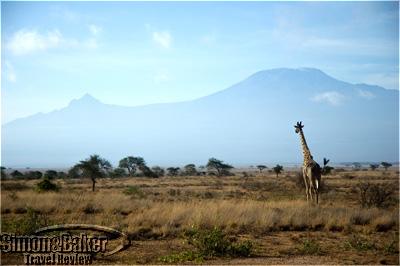
A view of Kilimanjaro from Porini Amboseli
A large number of visitors is drawn to Kenya by visions of abundant game roaming across endless open spaces punctuated by the wide umbrellas of flat-topped acacias, and proud Masai in crimson robes herding their cattle in the distance. To accommodate these visitors, the country has developed one of Africa’s most advanced tourism infrastructures, including large-scale accommodations, making it a favorite destination for group tourism. But as Kenya’s popularity as a safari destination increased, so did the potential threat to its environment. Gamewatchers Safaris has been at the forefront of addressing the challenge of enhancing the tourism experience while giving landowners a chance to improve their quality of life in the present, and preserve land and wildlife for the next generations.
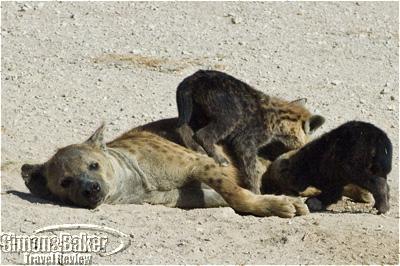
Hyenas at Porini Amboseli
With its four Porini Camps (Amboselli Porini, Porini Rhino, Mara Porini and Porini Lion) Gamewatchers Safaris offered an innovative solution: small tented camps (between six and ten tents depending on the camp) on private conservancies located in close proximity to the famed Amboseli and Masai Mara National Parks; with the exception of Porini Rhino Camp, which was in the heart of one of the largest rhinoceros sanctuaries in East Africa, in the shadow of Mount Kenya. In these rigorously eco-friendly camps, great efforts were made to minimize the impact of the properties on the environment. No permanent structures were erected, power was exclusively solar generated, and all waste was managed according to strict procedures.

A Masaai woman and child at a Porini property
The host conservancies were on private land leased from the local Masai tribes who received financial benefits and employment opportunities as well as infrastructure development (such as roads and improved access to water). Local tribesmen had access to training in various aspects of the tourism industry and employment at the camps. As the time of my visit close to 90 percent of the camps’ staff came from local tribes. Because of this close partnership, we, as camp guests enjoyed extensive contact with the local community, such nature walks with Masai Warriors, visits to the local villages where we were welcomed and allowed to observe the tasks of daily lives as well as celebration songs and dances. We were also able to enjoy nighttime game drives (these, like the walking safaris were not allowed in the National Parks). I especially enjoyed the opportunity for substantive conversations with my Masai guides about their tribes’ history, current lives and aspirations.
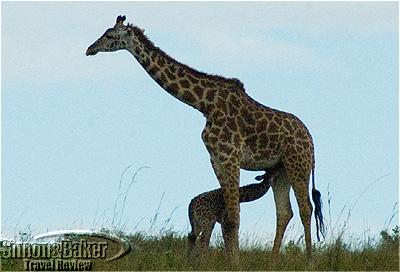
A baby giraffe feeding at Porini Lion Camp
Each camp was located in a spectacular site with its own game watching particularities. Click on the name of the camp to read about my memorable safari experience at each one of the Porini camps:
Amboselli Porini Camp was in the Selenkay Conservancy, adjacent to the north side of the Amboselli National Park, famous for the large herds of elephants roaming its sun-baked plains. Access to the park was via the conservancy’s private road, against the eye-popping backdrop of Mount Kilimanjaro.
Porini Rhino Camp was located on the verdant plateau of the Ol Pejeta Conservancy, between the foothills of the Aberdares Range and the stately snow-capped peak of Mount Kenya. In addition to its large rhino population, it featured large herds of rarely seen herbivores such as reticulated giraffes and Grevy’s zebras.
Mara Porini Camp was nestled in a soaring grove of yellow-barked acacia, within the Ol Kinyei Conservancy, ten miles away from the Northeast boundary of the Masai Mara National Reserve. The conservancy was host to a large resident pride of lions that I had the pleasure to observe repeatedly. Early morning game drives on my way to the park in the rolling meadows filled with herbivores browsing for their breakfast in the clear morning air were a special treat.
Porini Lion Camp was in the Olare Orok Conservancy on the northern border of the Masai Mara National Reserve. The abundance of “big cats” in the conservancy and this area of the park was such that it was hard to keep focused on any other game! Although the sight a pair of black rhinos engaged in courtship ritual did hold my attention, as did a breeding herd of elephants with several newborn calves; successfully tracking an elusive leopard was a high point of the visit, so was a pride of lions getting ready for their hunt. In the end the antics of a cheetah and her three tiny cubs won my cuteness award for the stay.

A hippo at Porini Lion Camp
Another feature that further enhanced my game-watching experience was that all game drives took place in custom-built, open-sided Land Rovers, each with three tiers of two individual seats. Although the vehicles could accommodate up to six guests, there were never more than four of us in any vehicle, and more than once I had the pleasure of a private game drive. One slight drawback: it was sometimes a challenge to repress the urge to gloat a tiny bit as I met covetous glances coming from the air-conditioned minivans I occasionally passed in the parks.
N.B. Shortly after my visit, Porini Safari Camps and its parent company Gamewatchers Safaris were honored with the Responsible Tourism Award for “Best for Conservation of Endangered Species outside Protected Area” at the 2008 World Travel Market in London. The award, sponsored by Virgin Holidays, recognized Porini/Gamewatchers “for demonstrating that a high revenue, low impact tourism development approach can benefit the local Masai through developing conservancies and tourism in partnership with safari companies to create employment and community income and to conserve their land for wildlife.”
Listen to John Jackson, manager and executive chef, Royal Malewane

John Jackson, manager and executive chef, Royal Malewane
During a visit to Royal Malewane in South Africa late last year, Elena del Valle had an opportunity to chat with John Jackson, manager and executive chef at the luxury safari property within the Thornybush Reserve near the famous http://simonandbaker.com/kruger. She and Gary enjoyed their stay at the celebrity friendly reserve and as a result we published a dedicated feature on Royal Malewane.
Click on the play button below to listen to their conversation.
Day sailing offers fun way to experience historic small Down East seaport
Article and photos by Josette King

In New England parlance, Down East refers to the northern coast Maine from the Penobscot Bay to the Canadian border, an area famous for its rocky shore festooned with countless harbors and inlets, and for some of the best waters for sailing and boating. Located on the western shore of the Penobscot Bay, an easy three-hour drive north of Boston, the quaint little seaport of Rockland was a delightful spot to enjoy the waning days of the New England summer.
The waterfront was alive with commercial fishing and lobster boats as well as recreational sailboats, sea kayaks and canoes. Sightseeing windjammers provided a wide array of opportunities to enjoy the calm waters of the bay and explore its jagged shores punctuated by historic lighthouses. A variety of cruises was available to enjoy the spectacular vistas of the bay and experience the varied aspects of life around the bay and the rugged coastline of the Gulf of Maine. These were my most memorable:
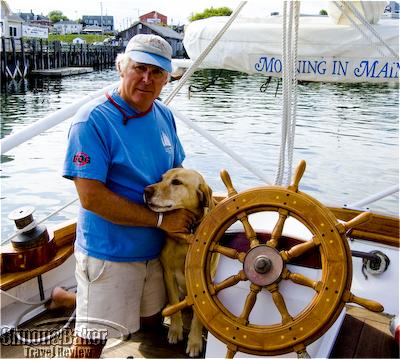
The Morning In Maine
Morning In Maine
My first sailing experience on the pristine waters of the Penobscot Bay was a cruise on Morning in Maine, the elegant 55 foot (17 meter) ketch of Captain Bob Pratt. A marine biologist formerly on the faculty of the University of Maine and the Maine Marine Academy, Captain Pratt is also a seasoned ocean sailor. He had the ketch smoothly gliding along while giving his dozen guests a thorough introduction of the wildlife and human activity around the bay; from harbor seals peering at the edge of the waves and seabirds soaring about to lobstermen checking their traps, and lighthouses standing guard on their promontories. It was two of the shortest hours I ever spent on the ocean.
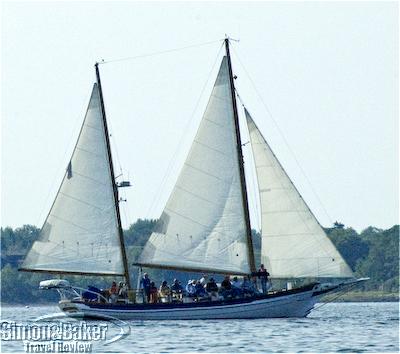
Captain Jack Lobster Boat Adventures
For another memorable sea adventure I joined veteran lobsterman Steve Hale aboard his 30 foot (nine meter) traditional lobster boat, the Captain Jack (named after Captain Steve’s grandson), as he hauled his traps out of the bay. Captain Steve was a wealth of information about everything crustacean, from their life cycle to the steps necessary to ensure the preservation of the lobster stock. Each new trap was a fresh opportunity to illustrate a point. Was the lobster too small? It must be thrown back for a chance to grow some more. When in doubt, a slide rule dictated. One hefty specimen surfaced, a “keeper” for sure.
But Captain Steve showed us otherwise: this one sported a small V cut in its tail, branding her as an egg-producing female. Now she could never be kept, whether she presently had eggs or not. Another trap held a specimen that had just shed its shell. This one was lowered back in the trap, to give it time to harden a bit. One hour and a dozen keepers later, we headed back for the harbor. Again time had flown much too fast as I thoroughly enjoyed every instant of my lobstering experience.

Moneghan Boat Lines Lighthouse Cruise
Departing from Port Clyde, a small fishing village a short 30 minute drive south of Rockland, this two-and-a-half hour cruise offered a close-up view of some of the most picturesque lighthouses on the Gulf of Maine. Our ship, a 65 foot (20 meter) converted World War II model T-57 mail boat, well known in the area as the Moneghan Lines Laura B, took us past several lighthouses including the Marshall Point light, with its unique angled wood plank bridge leading a colonial style light keeper’s house. Marshal Point had its minute of Hollywood fame when it briefly shared the screen with Tom Hanks in Forrest Gump.
From there we headed to the Tenants Harbor light. Built on an island at the entrance to Tenants Harbor, it was purchased in 1978 by artist Andrew Wyeth. It is now the private residence and studio of his son, artist Jamie Wyeth. We continued past the Whitehead and Owl’s Head lights before heading to Two Bush Island light, a stark 42 foot (13 meter) high square tower built on a sliver of barren land ten miles from the coast. This ocean excursion was a rare opportunity to visit otherwise inaccessible areas of the coast.
I thoroughly enjoyed my time by (and on) the sparkling waters of the Penobscot Bay. I will recommend Rockland as a mandatory destination to any friend wishing to experience the authentic essence of Down East Maine. Click here to for more on my visit to Rockland.
Cape Town Asian fusion restaurant blends East, West
Article by Elena del Valle and photos by Gary Cox
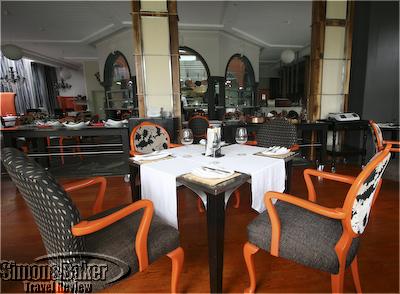
The dining room at Myoga
Nestled within the Vineyard Hotel and Spa grounds in a pleasant residential neighborhood on the outskirts of Cape Town, Myoga (60 Colinton Road, Newlands, Myoga.co.za, +27 21 657 4545) offered tasty Asian fusion dishes in a pretty garden side setting. An open kitchen design allowed us to see the staff at work on one side and take advantage of the terrace view of our window side table.
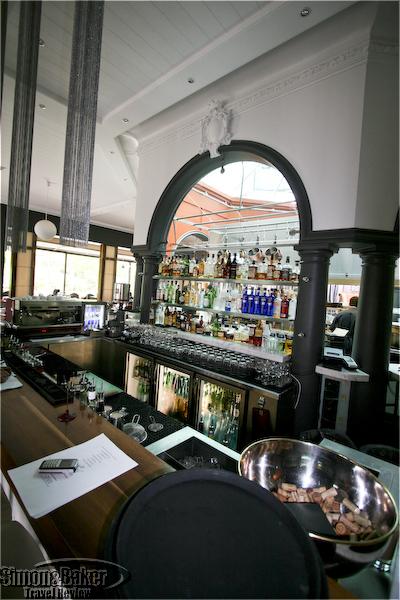
The bar
The decor of the 100-seat restaurant was young and chic with an Asian flair. Highlights included wood floors, orange, black, and wood colors, chandeliers and metal table tops. The funky bathroom had video screens in the stalls with a live feed from the kitchen. Myoga, named for the Japanese word for ginger blossom, was one of three owned by Chef Mike Bassett, well known for Ginja, a Cape Town restaurant.
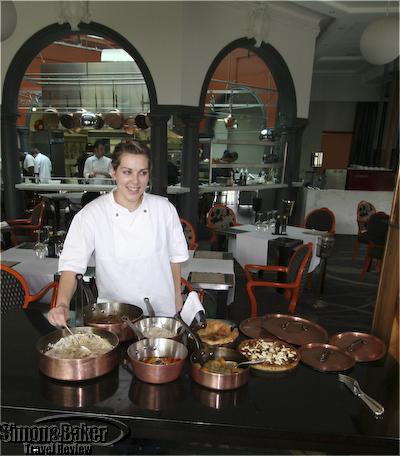
Myoga chef at buffet table
Although we were tempted by the lunch buffet with hot and cold options, we ordered a la carte. There was a healthy size wine list including many options of wine by the glass. Our server, Tami, was friendly and shared input on the menu options. We tried a glass of the Simonsig Brut Rose 2006 Cap Classique sparkling wine to match our East meets West appetizer selections: a delicious spinach pastry and potato accompanied by yummy sauces.
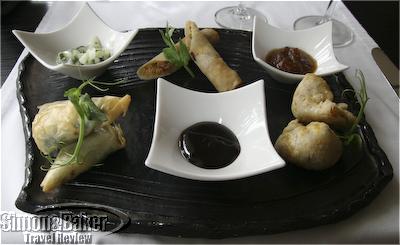
Myoga appetizer
For mains we had the Chicken Tikka which was delicious and rather hot; Chiken Pie which was especially savory thanks to a secret ingredient (black truffle oil); and Chicken Curry with mustard and a very mild blueberry chutney.

The pineapple dessert
For dessert, we had a chocolate plate with dark chocolate and tart blackberry sorbet, and a delicate pineapple dessert with dehydrated pineapple slices, mascarpone ice cream and rhubarb soup. It was a pleasant meal, well served and in a relaxing verdant setting. Anytime we’re near Myoga again we will consider a stop.
Las Vegas bistro offered oriental specialties and ambiance
Article by Elena del Valle and photos by Gary Cox
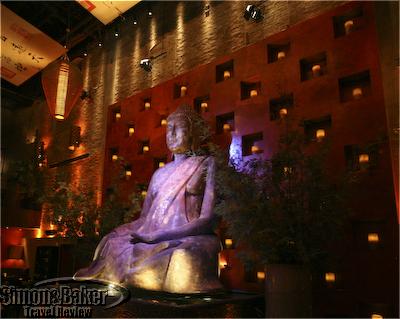
Tao buddha
Except for the near empty state of the large restaurant (we arrived in the late afternoon) it would have been hard to tell what time of day or night it was inside Tao Asian Bistro (3377 Las Vegas Blvd. South, Las Vegas, NV 89109, +1-702-388-8338, Taolasvegas.com). Such was the style of the nightclub and bistro which could accommodate 2,000 guests. Located at The Venetian Resort-Hotel-Casino, the two-story restaurant was crawling with shadows that made it appear mysterious. Done in a slightly different way it could have felt soulless but bright shades of red, brick walls, kanji characters reflected on the ceiling and larger than life decorative oriental artifacts lent it a certain magic. It had the air of a place that comes alive with patrons, especially in the evening.
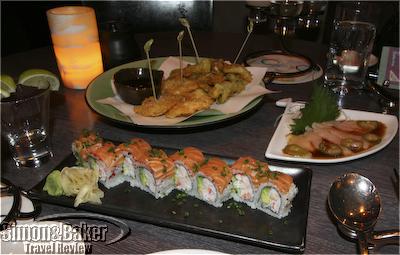
Tao appetizers
The hostess led us to the last booth, tucked away next to the kitchen door and across from a giant Buddha. Chris, our friendly and knowledgeable server, was with us moments later. At his suggestion, we tried two martinis: Tao-tini (Absolute Mandarin, Stoli Rasberry, Malibu Rum, cranberry and fresh lime juice) and a Lychee Martini (Ketel One, Triple and fresh luchee puree). For starters we shared the Yellowtail Sashimi with Jalapeño and Ponzu Sauce (a favorite); Alaskan Salmon, Crab and Avocado Roll; Kimchee and Baby Shanghai Bok Choy with Garlic.

Wok Seared New York Sirloin with Shiitake Mushrooms and Szechwan Potatoes
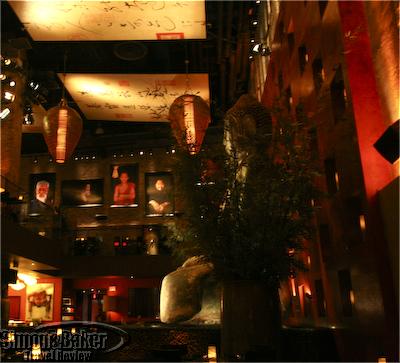
View of the Tao dining room from our seats
Then, our main courses arrived, a mountain of tasty food: Satay of Chilean Sea Bass with Wok Roasted Asparagus (a favorite); Lobster Wontons with Shiitake Ginger Broth; Sandpot Lobster, Shrimp and Scallops with Black Bean Sauce; Wok Seared New York Sirloin with Shiitake Mushrooms and Szechwan Potatoes; Jasmine White Rice, and Mandarin Sizzled Fried Rice with Duck. Chris recommended an ice cream dessert which we enjoyed. These culinary creations were the work of Mark Andelbradt, Tao’s executive chef, and Koji Noda, the executive sushi chef, and their staff.
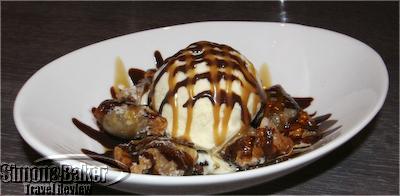
Our dessert
We washed it all down with six types of sake (Chris recommended this) including three “crazy fun” ones. He brought us the Spirit and Eternal selections from the sake by the glass menu. As we headed to our show (that’s why we arrived so early), the thought occured to me that although we sampled lots of savory dishes and drinks we would were pleasantly satisfied. We had a fun and enjoyable dinner at Tao.
The Kindle, my favorite new technology device for people who like to read
By Chester Godsy
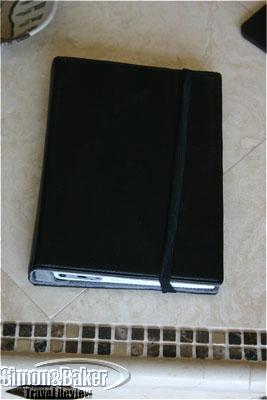
The Kindle closed
I have been very happy with my new Amazon Kindle. The readability of the screen is what really makes this device work. For the display it uses a type of opaque screen technology called E Ink. This display works very well in all types of lighting situations except for in the dark because it isn’t back lit. I would compare the screen very closely to the quality of a paperback book.
I finished reading several books on my Kindle. Soon after purchasing my first Kindle book we went on a long car trip across the country. During this trip I finished reading my first book. With no more books to read I then enabled the Kindle’s cell phone interface and began browsing the online Kindle book store (currently claiming over 240,000 titles) and found another book that I wanted to read. I purchased the book and it downloaded automatically to my Kindle as we were driving down the road. I was pretty happy to be able to get another book to read while riding down the highway in a car.

The Kindle open
Kindle book prices seem to always be lower than paperback versions; discounts vary anywhere from around a 25 percent to 75 percent over the paperback book versions. The Kindle uses a cellular phone network to download content from Amazon. The cellular phone interface is built into the Kindle and can be enabled or disabled with a switch located on the back of the device. As long as you use the built cell phone network to browse the Amazon store and download its content there is no extra charge for the cell phone connection time.
Another feature of the Kindle that I tried is the ability to convert document files into the Kindle book format. There are two methods of conversion available for Kindle users. One version requires payment to convert the document and then it automatically downloads to your Kindle. I used the free version to convert some technical papers into the Kindle format. With the free version it is necessary have to copy the converted files manually to your Kindle using a USB cable.
There are a couple of experimental features on the Kindle. One of them is the ability to play music. I downloaded mp3 files to my Kindle and tried this feature. It is a very primitive audio player. It just played the music I downloaded in a loop. I found this good if I want relaxing background music playing while I read. The other experimental feature is web browsing which I did not try because of the extra charges I would have incurred to access the web from my Kindle. Aside from the experimental features, after eight weeks I am pleased with the Kindle as a device to read books.
Click here to buy Kindle: Amazon’s Wireless Reading Device or
the new Kindle 2: Amazon’s New Wireless Reading Device (Latest Generation)







